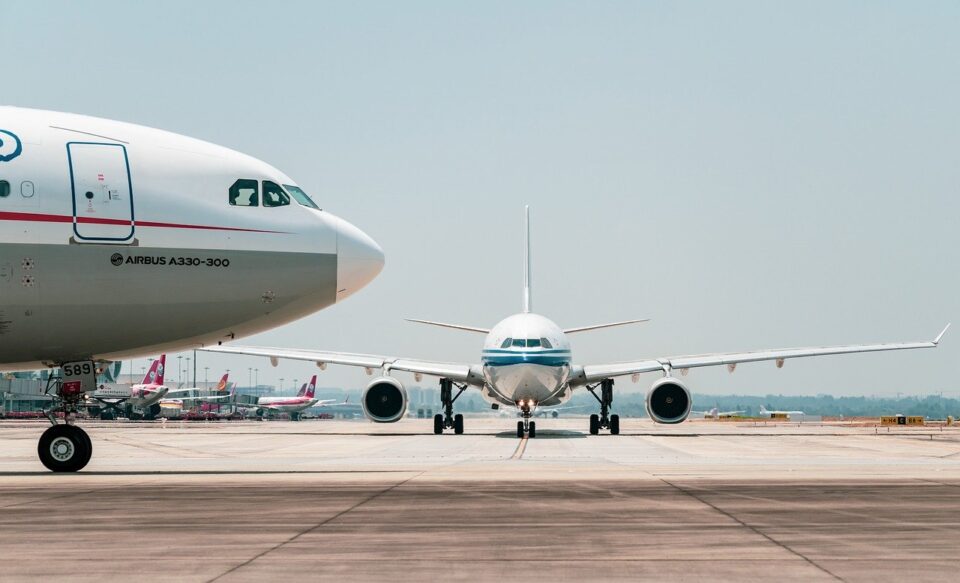Aerospace
SpaceX’s satellite internet service is coming to planes
SpaceX’s satellite internet service Starlink will soon be accessible aboard some planes

With the official launch of Starlink Aviation next year, SpaceX’s satellite internet service Starlink will soon be accessible aboard some planes, the firm has revealed. According to the company, the service would provide internet speeds of up to 350 Mbps to any aircraft fitted with its Aero Terminal. This speed is sufficient for video calls, online gaming, and “other high data rate activities.
How Does In-Flight Wi-Fi Really Work?(Opens in a new browser tab)
According to SpaceX’s website, its internet connections will be accessible during taxi, takeoff, flight over land and ocean, and landing, with latency as low as 20ms. An FAQ states that “Starlink Aviation will offer worldwide coverage.” As opposed to geo-stationary satellites, which are static, low-earth orbit satellites are always overhead or close to deliver a powerful signal at high latitudes and in polar regions. Beginning in mid-2023, deliveries are anticipated.
Starlink Aviation was able to provide onboard internet at a speed of 100Mbps. The test was carried out by JSX, which declared in April that it will be among the first airlines to use the in-flight internet service, on a route from Burbank to San José, California.
Frontier Airlines Hiring Candidates With No Flight Experience(Opens in a new browser tab)
In September, JSX CEO Alex Wilcox stated that he anticipated making it available to passengers this month and having the technology installed on every aircraft operated by the company by the end of the year. In April, Hawaiian Airlines also announced a deal with Starlink, with installation beginning the next year.
The goal of SpaceX’s Starlink project is to create a worldwide, interconnected network of satellites that will provide high-speed internet. Nearly 3,500 Starlink satellites have been sent into orbit by SpaceX, and as of June, the service has about 500,000 subscribers. With $2 billion raised just this year, the business has been rapidly raising funds to support the construction of both Starlink and its next-generation rocket Starship.

Aerospace
Which is bigger 777x or 787 aircraft ?

The 777X is a new series of the Boeing 777 family and is designed to be larger and more efficient than its predecessor. It features two variants: the 777-8 and the 777-9, being the larger of the two.
The Boeing 777X emerges as the larger sibling within the Boeing family, representing a significant leap forward in both size and efficiency. Comprising two variants, the 777-8 and the 777-9, the latter takes the crown as the larger of the two. With its expansive fuselage and impressive wingspan, the 777X is tailored for long-range journeys and boasts a substantial passenger capacity.
On the other hand, the Boeing 787, affectionately known as the Dreamliner, occupies a niche in the market as a smaller yet formidable aircraft designed for medium to long-range flights. Its distinguishing feature lies in its composite fuselage, a technological marvel that renders it lighter and more fuel-efficient compared to conventional aluminum counterparts. The Boeing 777X is larger than the Boeing 787 aircraft.
When it comes to passenger capacity, the 777-9 reigns supreme, typically accommodating a sizeable contingent of 400-425 passengers in its standard configuration. In contrast, the 787, with its more modest dimensions, typically carries between 240-290 passengers, depending on the variant and layout.
One of the remarkable innovations introduced with the 777X is its folding wingtips, a feature designed to address the logistical challenges of accommodating such a large aircraft in conventional airport gates. These folding wingtips enable the 777X to retract its wings, allowing it to fit into gates designed for smaller aircraft while still reaping the benefits of an extended wingspan during flight, thereby enhancing fuel efficiency and operational flexibility
Aerospace
China Secures Production Certificate for Mass Production of Pilotless eVTOL Aircraft

The first passenger-carrying pilotless electric vertical takeoff and landing (eVTOL) aircraft in the world, the EH216-S, has received the Production Certificate for its eVTOL aircraft from the Civil Aviation Administration of China (CAAC).
This is a significant milestone for EHang Holdings Limited, the leading UAM technology platform company in the world. This outstanding accomplishment is another big step towards mass manufacturing for the eVTOL aircraft and the ensuing commercial operations, building on the ground-breaking acquisition of the Type Certificate and the Standard Airworthiness Certificate for the EH216-S.
The PC is a crucial certificate that the aircraft maker receives from the CAAC, the country’s aviation authority. By obtaining this certificate, EHang has demonstrated that it has set up a quality management system for mass production that satisfies the airworthiness regulation standards set forth by the CAAC, and the company has been given permission to continue producing mass quantities.
It is also a strong guarantee of the calibre of the goods made by EHang. Raw materials, supplier management, manufacturing organisation, production quality control, aircraft pre-delivery test, after-sales repair and maintenance, etc. are all included in the mass production quality management system for the EH216-S.
To ensure that every aircraft and its components that roll off the production line strictly adhere to the approved type design and safety requirements, the system sets clear guidelines and documentation for every step in the production procedure. This ensures comprehensive traceability and safety control.
Aerospace
Four Airbus A380 Superjumbos lined up to be scrapped

In a strategic move aimed at reclaiming valuable resources from the iconic Airbus A380 aircraft, VAS Aero Services and Dr. Peters Group have announced a significant collaboration.
This partnership marks a milestone in aviation logistics and aftermarket services, with four of these colossal planes slated for teardown and redistribution of used serviceable material (USM).
The venture between VAS Aero Services, renowned for its expertise in aircraft dismantlement, and Dr. Peters Group, a prominent Germany-based investment fund management firm, underscores a commitment to sustainable aviation practices. This isn’t their first foray into scrapping A380s; their successful partnership has already seen the dismantlement of these aircraft, making them pioneers in this niche.
Under the agreement, the latest consignment brings the tally to eight A380s entrusted to VAS by Dr. Peters Group. Managing Director Christian Mailly of Dr. Peters Group emphasized the trust placed in VAS, citing their unparalleled capabilities in dismantlement and aftermarket sales network. It’s a strategic move in response to the growing demand for quality USM parts, particularly with the resurgence in reliance on the A380.
Notably, the teardown process will be carried out at various locations, optimizing the positioning of harvested parts to cater to different markets. While some parts will be positioned in Europe to support operators in the region and the Middle East, others will remain in the Asia-Pacific region. This meticulous strategy ensures efficient access to spare parts, benefiting MROs and airlines across these markets.
The decision to retire these A380s comes at a time when operators are reassessing fleet strategies amidst evolving market dynamics. Despite initial plans for quick retirement due to the emergence of more fuel-efficient alternatives, factors such as a rebound in long-haul demand and delays in new widebody deliveries have prompted operators to reconsider. The A380, with its unique capacity and capabilities, presents a practical solution for short-term capacity management.


























